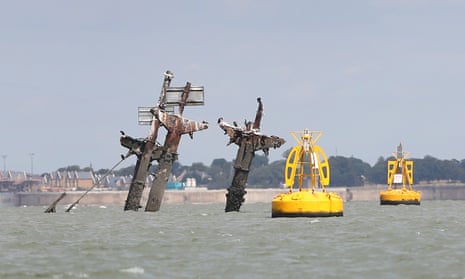It is 75 years this Tuesday since the SS Richard Montgomery sank off the Kent coast on its way to allied-occupied France. But the remains of the US cargo vessel, which went down on 20 August 1944, with more than 6,000 tonnes of munitions on board, continue to haunt the Thames estuary.
With politicians and salvage experts divided over the extent of the threat that the most monitored wreck in British waters poses beneath the waves, there are fresh fears that the ship is breaking up, leading to concerns its potentially explosive cargo could be scattered across the seabed.
Two surveys, from November 2017 and April 2018, indicate that the wreck is stable overall but is showing accelerated levels of deterioration.
Labour peer Lord Harris, who takes a close interest in the vessel, said that experts had told him “the wreckage of the SS Richard Montgomery may only have a few years remaining before it disintegrates completely”.
This would pose new safety challenges for containing the wreck, which lies only 15 metres below the surface and whose rusting masts can be seen above the waves in all weathers. More than 5,000 vessels pass close to it each year. In May 1980 there were two near misses within a week. In the first, a ship, the MV Fletching, came within 15 metres of the wreck. The second saw the Danish-registered Mare Altum, a 1,600-tonne chemical tanker, diverted from a collision course with the wreck with only minutes to spare.
Access to the wreck is prohibited under the Protection of Wrecks Act 1973. But this has not stopped people visiting the site. The last known incursion into the area was by a paddle-boarder in 2015.
In a parliamentary debate last month, Harris said he had learned that a boat carrying three men and explosives was stopped in a security operation near the wreck during the 2012 Olympics. He asked: “Was that security operation simply precautionary or was it in response to a specific threat? Indeed, what mitigations are in place to prevent a terrorist attack on the wreck?”
In the same debate, the Labour peer Lord Berkeley said: “There is an awful lot of evidence suggesting these kinds of explosives, having been sitting on the seabed for 70 years or so, actually get more dangerous rather than less.”
The Maritime & Coastguard Agency (MCA) estimated that, after salvage operations, some 1,400 tonnes of munitions remained in the ship’s forward holds. But others suggest there could be more than double that amount.
In 1970 the former Royal Military College of Science predicted that an explosion on board would trigger a five-metre-high tsunami. Its report suggested that the shock would shatter almost every window in nearby Sheerness and damage buildings. But whether the munitions could still explode divides experts. A 1999 MCA report confirmed only that “the risk of a major explosion is believed to be remote”. In 2004 a New Scientist investigation concluded that the cargo could be detonated by a collision, an attack or shifting tides.
Proposals to move the wreck have been discounted on the grounds of cost. Plans to remove the remaining explosives would require the evacuation of people living nearby.
The Department for Transport recently commissioned additional monitoring around the wreck, “a pre-emptive move as part of our ongoing commitment to manage the wreck”.
The Conservative MP for Sittingbourne and Sheppey, Gordon Henderson, recently reassured his constituents living nearby that the government was watching the wreck closely and there was no cause for alarm. “The overall situation of the SS Richard Montgomery has not changed,” he said. “The non-intervention policy that has been in place for several decades, under successive governments, is still the best option.”
However, Harris said that he feared “nothing had been done” to make the wreck safe in the last 75 years. He asked his fellow peers: “Perhaps the biggest question of all is: who will take responsibility for what happens if it all goes wrong?”
